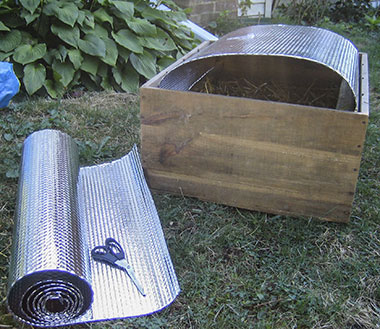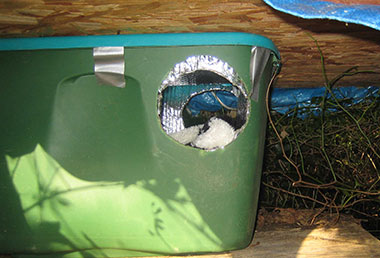

Carrier lined with reflective insulation and a plush throw for comfort. For use inside a space protected from rain and weather.

Wooden box (you can use a plastic box) lined with reflective insulation, packed with straw and reflective cover over it and tucked into sides. This one is open on both ends, which many cats prefer. For use inside a space protected from rain and weather.

This is a small plastic storage container, completely lined with insulation, including the underside of the lid, and filled with a synthetic blanket. Two 5-inch holes have been cut out at one end. Although it's best to have a hole at either end, this prevents a cold draft across the cat which will keep it warmer. This will work as long as the cat is using. You can save the cut-outs in case you want to close up a hole and make one at the other end opposite the first one. This one is being used by feral cats in a wooded area surrounded by deep thickets.
Sheltering Homeless Cats
Winter is especially hard on homeless cats living outside. There are longs days and nights in cold and wet weather. Access to food and water can be more difficult. Food and water can freeze. Warm, dry quarters will help homeless cats get through the winter. After years of trial and error in providing shelters for homeless cats, here are some tips that have worked for us.
They are most apt to sleep in places that are protected from their predators, particularly coyotes, and the weather. They will usually not use a stand-alone shelter in a yard or woods that is not protected by a bigger barrier. Sheds, outdoor showers, boats and low decks work best. So, if you have one of these spaces, it's easy to make a small shelter using a small pet carrier, some reflective insulation and a big armful of straw (not hay), which can be bought very cheaply loose in bags at a feed and garden store. The shiny insulation is available in hardware stores and comes in rolls that look like shiny bubble wrap and are easy to cut with a scissors. It is somewhat expensive. If you need to, call us to see if we have extra. Styrofoam can also be used. It insulates well but won't reflect the cat's body heat. The closer the insulation is to the cat's body, the warmer it will be, so don't use too large a carrier. Here is a picture of a carrier that is being used in the crawl space under a home.
Once you have a carrier (People for Cats may have extras if you ask), remove the door and line the inside completely with the insulation, using duct tape to keep it in place. Cover the lower half of the front opening with the insulation, too. Then fill with a lot of straw. We have also used synthetic plush-type blankets and throws (don't use cotton or wool which retain moisture) and they seem to work well, too. Place the carrier in the space you plan to use. A deck has to be low enough that a coyote can't get under it. If you are putting it in an outdoor shower that doesn't have a roof, you will have to put a piece of plywood, or a folded tarp, over the carrier to prevent rain or snow from getting in it. If you are putting it under a deck, you can put a piece of plywood or a table on the deck to protect the carrier underneath the deck. For a shed, if you can leave a window open enough for the cat to jump through, that will work. If you have a fenced in yard, a cat will feel more secure but you will still need to put the carrier in a shed, outdoor shower, under a deck, etc.
The first time you see your homeless cat go into or emerge from the shelter, or see that she has used it, it's a wonderful feeling to know that you are giving warmth and comfort to a cat this winter. If your cat isn't using the shelter, then it may have another place to sleep, but you can call us and we can try to help you find the reason she is not using it. Often cats like to see an escape hole before they will go into a closed space. So we also use plastic storage containers, completely insulate the inside, including the underside of the lid, and cut two 5-inch holes on either side of the container at one end. This seems to reassure the cat. Then we fill it with straw.
We may have extra materials to make winter shelters so please call the hotline, 508-540-5654, if you need help.
© People for Cats 2026
